“Thoroughly Modern: Women in 20th Century Art and Design†on view at the Speed Art Museum through July 1st, is being promoted as a sequel to the Speed’s next blockbuster, “Women Artists in the Age of Impressionism.†The achievements of female painters of the 1920s and 1930s are shown to consist of easel-sized, modestly-scaled works often accomplished in artists’ colonies -freer and less sexist environments than prominent art academies, which had only just begun to admit women.
Female artists also achieved prominence as designers of table wares in glass, silver and ceramics. Biomorphic and geometric ornament was vibrant and fully in touch with contemporary art in the period. It anticipated current concerns with the linkage between color abstraction and materiality, or ornament as an intrinsic element in visual language rather than an extraneous add-on.
“Thoroughly Modern†is also a pertinent prequel to the shows at the Kentucky Museum of Art and Craft (KMAC) of the work of Nathan Hayden, “What Was Magic of Numbers, Hypnotic and Wonders†and Amanda Ross-Ho, “Contents and Index.â€
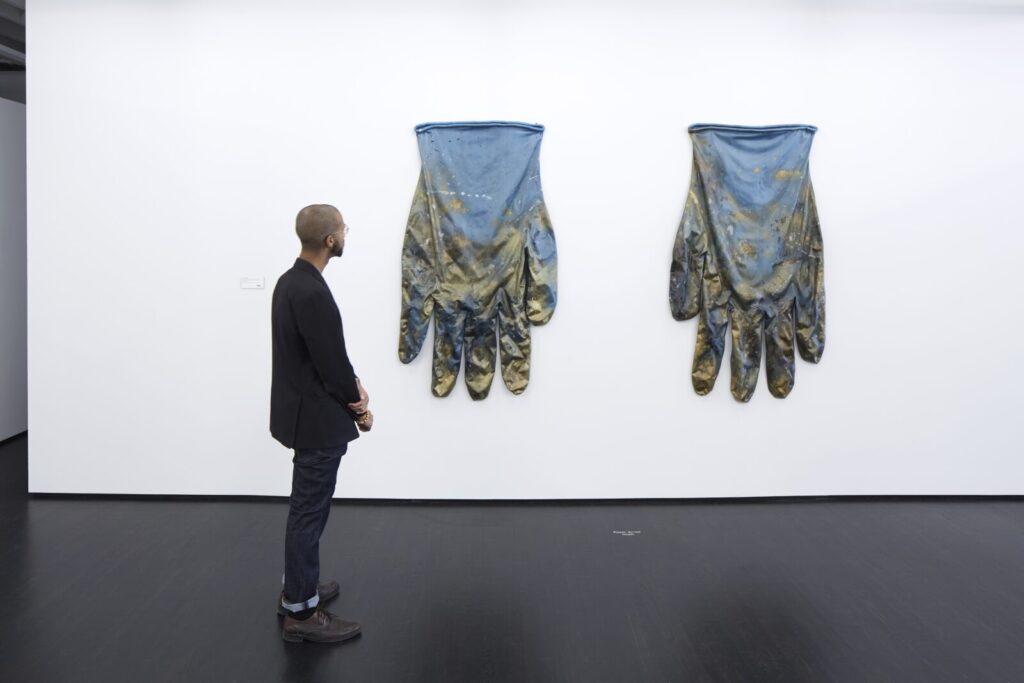
Craft at the Speed show remains in the traditional domestic sphere, one realm in which early 20th century women could gain professional recognition. The twin exhibitions at KMAC reference and subvert traditional notions of craft and gender roles. Both Ross-Ho and Hayden employ craft techniques but move decisively from the dining table to the sculpture pedestal, from the living room to the art gallery. Abandoning utility is to assert their artworks’ independent authority and hospitableness to multiple meanings. The hand is the instrument of mystical automatist transmission for Hayden, and for Ross-Ho it is the touchstone of surreal engagement with the studio environment as an extension of consciousness.
Hayden – like a hip-hop/electronic music version of a Sufi whirling dervish – dances for an hour a day to induce otherworldly visions. A former Louisvillian, Hayden’s works from his period in Kentucky (2004-2006) are miniature works in ink and acrylic wash with delicate stippling. Subsequently, Hayden made ‘cards,’ small drawings that are the source of his larger works. The print curator Carl Zigrosser wrote about ‘multum in parvo’ (a lot in a little) works of art in which “a multiplicity of detail is concentrated into a unified principle, the particular is transformed into the universal, and a largeness of meaning is conveyed with the utmost economy of means.†Hayden’s drawing is a practice of faith and the cards are mounted on small earthenware lecterns like a medieval book of hours intended for private devotions.

There is an intriguing tension between the imagery and its spiritual content. In “Unfalconable†accessibility and transcendence are in opposition. The paper is divided into quadrants, each depicting a Manichean contrast between black forms made up of rectangles and triangles, a yellow-orange ground, and hieroglyphs suggesting mountains, vegetation, celestial objects or adobe structures.
The imagery is vaguely southwestern, filtered through popular colors and motifs of the 1970s, in turn based on 1930s art deco, ultimately deriving from Mexican and Native American symbolic languages. Hayden turns the regional sense of place inside out, making a someplace a conceptual no place or an any place, ironically re-capturing the original cosmological implications of his forms. His method is more devolution than deconstruction.

Hayden’s larger works are earthenware forms in adobe pink clay and dyed wall hangings in industrial felt. The clay works are repetitive explorations of quadrilateral plinths with bisymmetrical curved or zigzag shapes. They provide a self-referential vocabulary lesson echoing the meta-language in the drawings and in their disciplined repetition of limited variations on winged flanges, harken back to 1950s and 1960s writers like M.C. Richards, whose book “Centering in Poetry, Pottery and the Person” captured the attitudes of ceramists like Shoji Hamada, Bernard Leach and William and Mary Scheier, who conceived of their potting as a form of meditation.
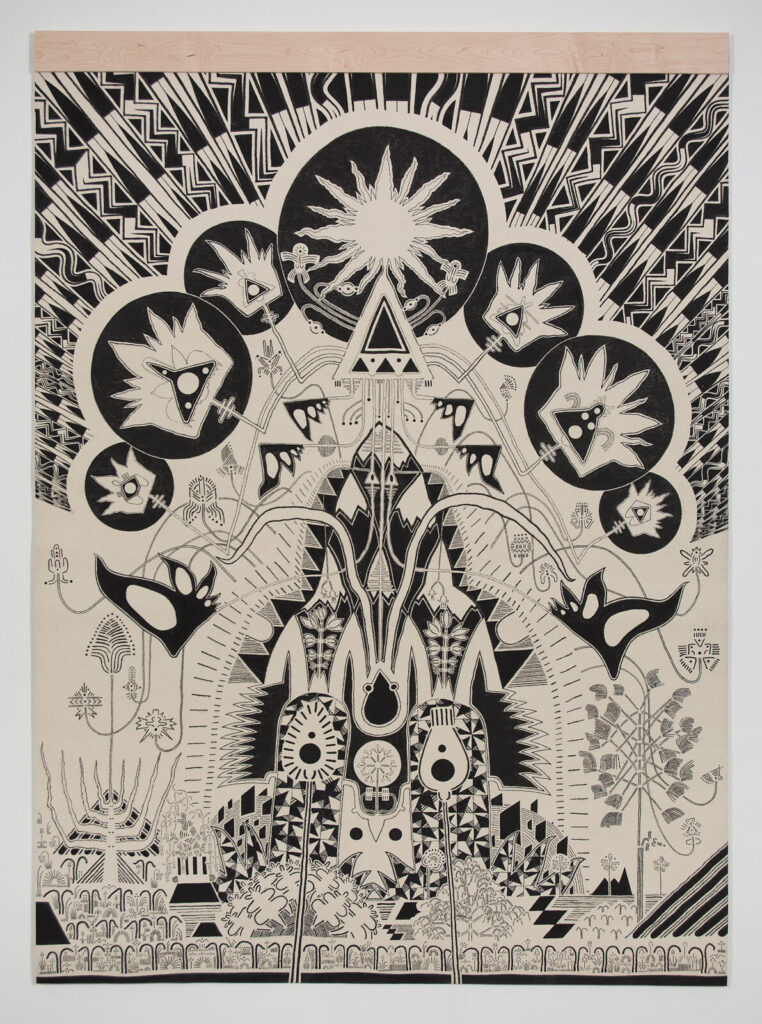
Hayden’s large industrial felt hangings either adhere to the visual vocabulary promulgated in the small drawings and ceramics or expand into otherworldly Mandalas of radiating chevrons, bristling nodes, bursting suns, seedpods and spiraling vortices. Segmented and bisected but asymmetrical, the largest hangings, for example, “what was meant to be here was no longer†evokes cosmic visions and assert the universality of root systems and natural structures.
Hayden acknowledges the influence of the Swedish visionary Hilda Af Klint, who shared with Kandinsky, Jawlensky and other pioneering abstract artists the influence of theosophical speculations on alternate states of being. In his use of clay and industrial felt, Hayden extends abstract modes of presentation and the resurgence of the handmade.
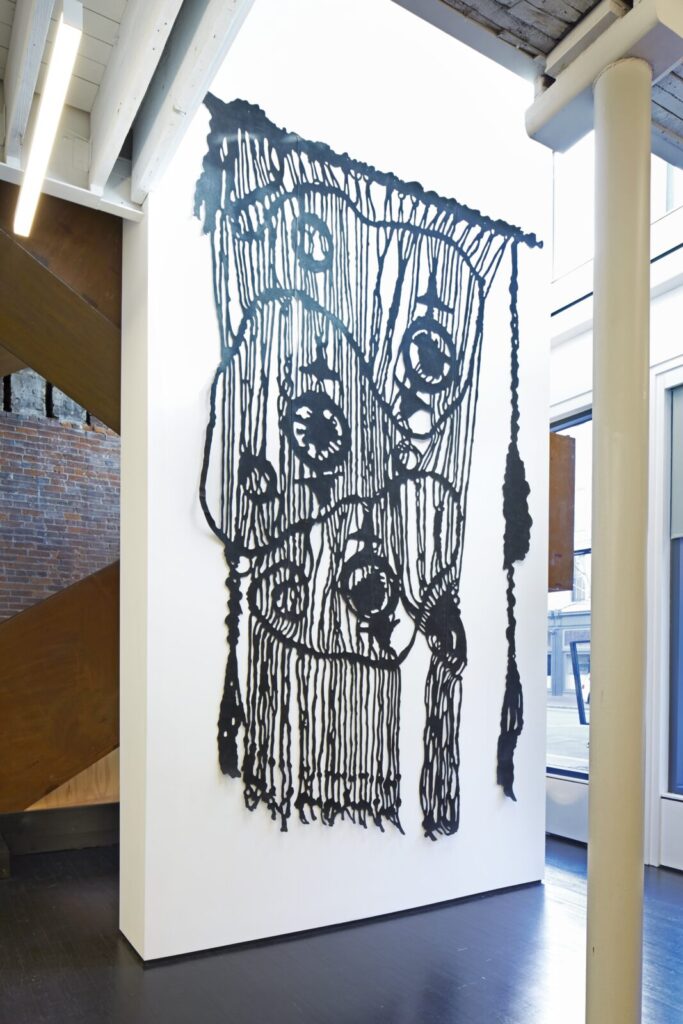
Amanda Ross-Ho also references craft traditions, especially traditionally feminine realms of weaving and needlework. She does so in a way in which female subservience or do-it-yourself amateurism associated with those arts is undermined. The fifteen-foot tall “White Goddess #16 (LA COTE) is a simulacrum of macramé in acrylic on canvas drop cloth. The one at KMAC is derived from a 1970s craft magazine and copied from a projection. Gargantuan imitation gloves are transformed from rubber to cotton and like the macramé, serve as emblems of labor, but also as stage props in a theater of the absurd or surreal artifacts from a liminal state between dreaming and pre-awareness.
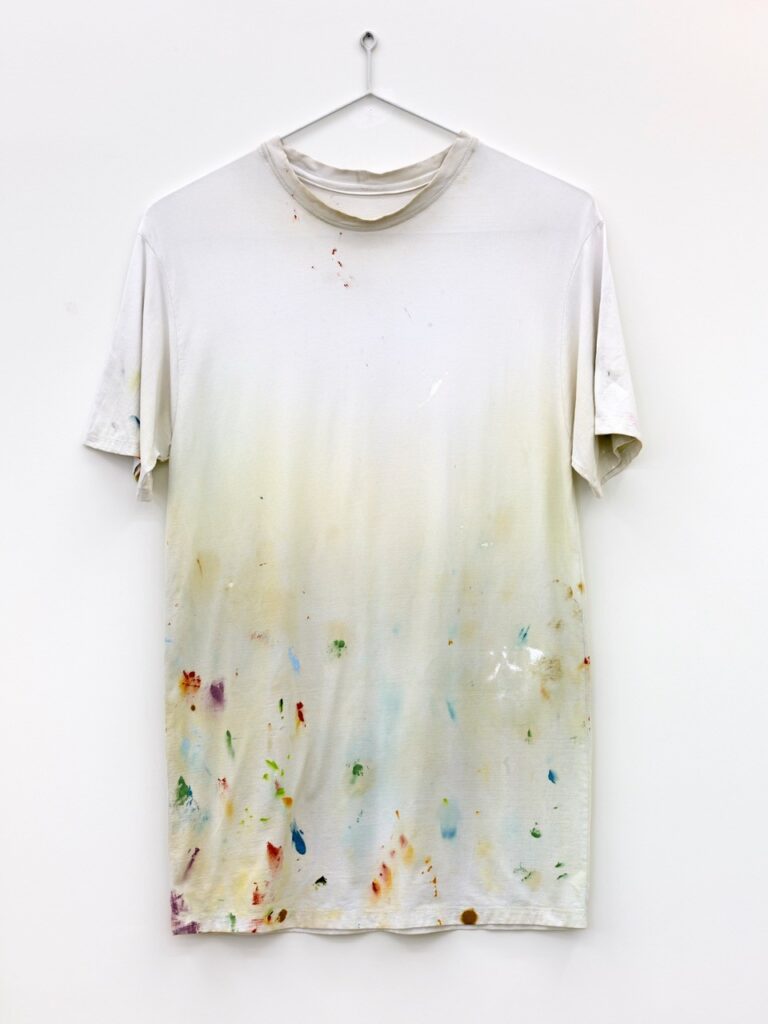
The artist’s frame of reference is the studio and workplace. Shirts and gloves show accidental spills and offer a metonym for the creative process. “T-Shirt (World Map)â€has an apparent sweat-stained collar. On the bottom of the shirt and on the sleeves are dashes and splotches of yellow, green, red and purple, like an abstract expressionist vocabulary lesson from a late painting by Hans Hofmann. “Untitled Smock (Accident)†is a retro purple smock with slash pockets and round snap buttons. It is stained with red paint, connoting a mishap, as the title indicates, or the feigned residue of the oeuvre of an artist using a poured paint technique, not unlike Helen Frankenthaler.
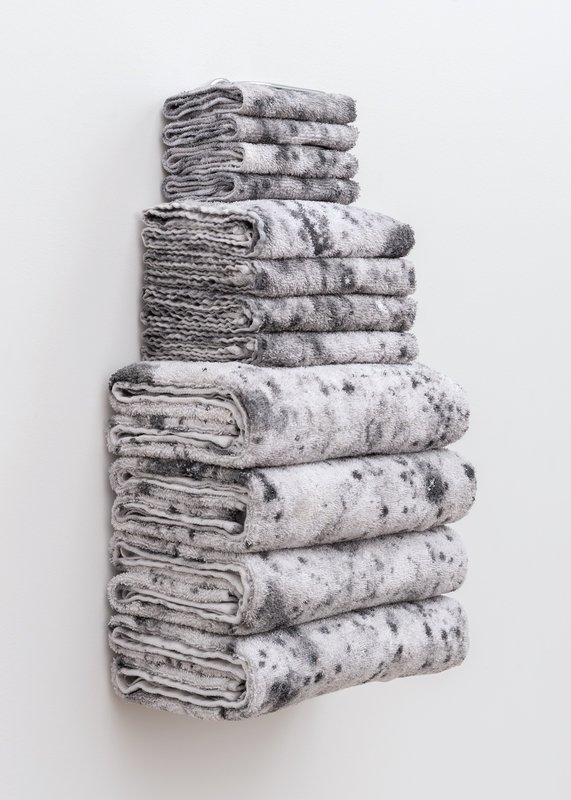
Work and the conditions of artistic operations are also covert protagonists in the implied drama of “Untitled Textile Arrangement (Towel Rack #6).†Undermining the sanitary sterility of hotel rooms, the viewer is left to speculate whether the black stained, neatly folded towels are the revenge of an irate chambermaid outraged by the oppressive conditions of her servitude, the side effects of an oil spill, or an expression of creativity in tie-dying. The clothes and towel racks broach the charged subject of employment. Art is work and the artist’s studio is the workshop in Ross-Ho’s imagery, parallel to other emotionally redolent work places that resonate with the hidden drama of diurnal activities.
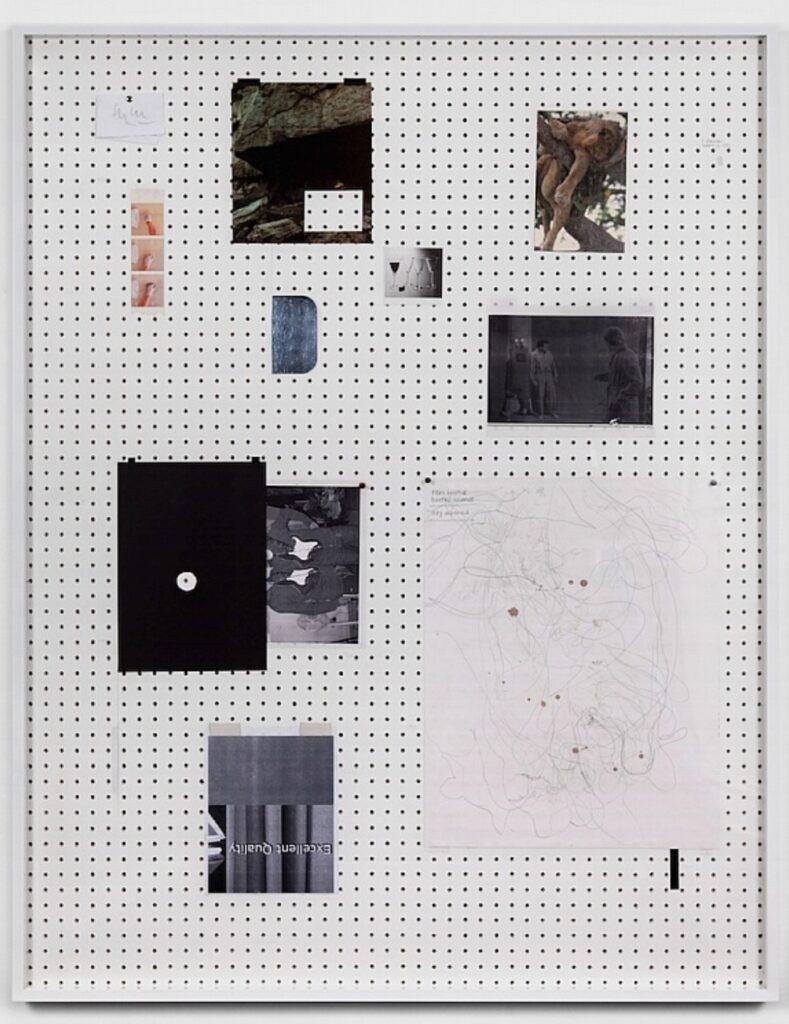
The studio is also a model of consciousness in Ross-Ho’s work and self-reflexively represents the cerebral conditions of art-making. “Untitled Still Life (Real Archive/I Know What to do†offers a model. The artist utilizes a pegboard format drilled by hand in slightly unconventional dimensions but with the standard one-inch interval between holes. Continuing the labor theme of the over-sized garments, pegboard connotes a utility area, like a garage, storage shed or workshop. It is a hallmark of the well-organized craftsperson or home improvement enthusiast, who uses peg hooks to hang peggable products or tools. The hooks are supported by gravity alone, and the well-installed pegboard has an even weight distribution along several mounting points.
There are no tools on Ross-Ho’s pegboards and instead they function as a quasi- bulletin board: the comparison to Leo Steinberg’s description of Robert Rauschenberg’s “flatbed picture plane†– a receptor surface – has already been made in discussions of Ross-Ho’s work. Steinberg anticipated parallels between Rauschenberg and Ross-Ho in noting “it seemed at times that Rauschenberg’s work surface stood for the mind itself – dump, reservoir, switching center, abundant with concrete references freely associated as in an internal monologue – the outward symbol of the mind as a running transformer of the external world, constantly ingesting incoming unprocessed data to be mapped in an overcharged field.â€
There are 12 additions to “Untitled Still Life: Real Archive/I Know What To Doâ€Â ranging from identical squiggles on a folded piece of paper to a color photo of a lioness sleeping in the crotch of a tree with one paw and two legs dangling. Ross-Ho also draws directly on the pegboard, circling a nail hole, marking a right angle and writing in pencil, “I know what to do.†She uses a variety of means to attach her images, including white linen tape, map tacks, book tape, aluminum thumb tacks and push pins. In one instance linen tape is simply attached to the pegboard itself with nothing held.
The images are at once mundane and intriguing: a manipulated photo of two men looking at scrawls on a wall with a teddy bear in the corner; a piece of black paper with an opening showing a pegboard hole partially overlapping a photo of two men in shirts printed with electric guitar images, one squeezing a remote photo bulb; a bearded man in a hat under a rock overhang, the rectangle cut out and revealing nine holes underneath. There is also a picture of macramé; a page of scribbles and wine stains on Bristol board labeled “real archive, digital archive, copy machine;†and a vertical sequence of a gloved hand sponging color onto a wall. Some photographs seem to reference Ross-Ho’s father’s profession of commercial photographer: an advertising photograph of four wine glasses and an image from an interior design ad with the words “Excellent Quality†appearing upside down.
Ross-Ho’s stream-of-conscious is more measured and less crowded than Hayden’s (or for that matter, Rauschenberg’s), and the pegboard support indicates that the accumulation of images and the associations they prompt are the work in the work of art as well as a departure point for other art production. Ross-Ho’s variety of adhesives may stand for the varying stickiness of memory, the place of the image in a hierarchy of the imagination, or a system of indexing. Like the holes in a sponge, the pegboard’s perforations reinforce the illusion of the flatbed picture plane as an absorptive surface. Contradicting the traditional role of the pegboard, and making it into an ersatz bulletin board – but a bulletin board without overtly pertinent or useful information – comments as well on everyone’s contemporary task of deciphering and sorting the daily welter of information and misinformation. Linkages between the textiles and the pegboards establish an allusive environment and protracted meditation on the creative process.
KMAC’S current mission statement proclaims “Art is the Big Idea, Craft is the Process.â€Â Hayden and Ross-Ho fit neatly within that expansive rubric.




